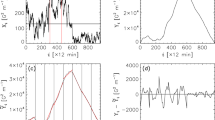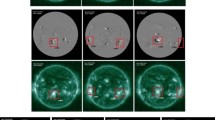Abstract
The paper presents a study of the evolution of the photospheric magnetic field of active regions (ARs) of the Sun in which flares (larger than the M9 class in the Geostationary Operational Environmental Satellite (GOES) X-ray classification) occurred in 2010–2017. The purpose of this paper is to detect the precursors of flares. Thirteen ARs at a distance of not more than 45 degrees from the central meridian are selected for analysis out of 31 ARs in which flares larger than M9.0 were detected in the specified period. The magnetographic characteristics of the selected ARs are studied based on the Solar Dynamics Observatory (SDO) data. A flare index is proposed. It is calculated from the data of the Helioseismic and Magnetic Imager of SDO (SDO/HMI) and reflects the distance between regions of opposite magnetic polarity computed between the field boundaries by the threshold value. The analysis showed that a sharp increase in the flare index is detected in all the studied ARs 2–3 days before large flares. Flares larger than the M9.0 class occurred 5–20 h after the global or local maximum of the flare index. It is shown using the example of individual events that regions of the opposite polarity first converged and then relatively quickly separated from each other before large flares. The revealed features of evolution of ARs before large flares can be used to develop methods for predicting them.





Similar content being viewed by others
REFERENCES
Abramenko, V.I., Multifractal analysis of solar magnetograms, Sol. Phys., 2005, vol. 228, pp. 29–42.
Abramov-Maximov, V.E., Borovik, V.N., and Opeikina, L.V., Microwave radiation of solar active regions before X flares according to the RATAN-600 observations in 2011, Geomagn. Aeron. (Engl. Transl.), 2013, vol. 53, no. 8, pp. 989–996.
Abramov-Maximov, V.E., Borovik, V.N., Opeikina, L.V., and Tlatov, A.G., Peculiarities of the development of active regions on the Sun prior to strong X-class flares: Joint analysis of data from the RATAN-600 radio telescope and SDO space observatory, Cosmic Res., 2014, vol. 52, no. 1, pp. 1–14.
Abramov-Maximov, V.E., Borovik, V.N., Opeikina, L.V., and Tlatov, A.G., Dynamics of microwave sources associated with the neutral line and the magnetic-field parameters of sunspots as a factor in predicting large flares, Sol. Phys., 2015a, vol. 290, pp. 53–77.
Abramov-Maximov, V.E., Borovik, V.N., Opeikina, L.V., and Tlatov, A.G., Precursors of the solar X flare on March 29, 2014, in the active region NOAA 12017 based on microwave radiation and magnetographic data, Geomagn. Aeron. (Engl. Transl.), 2015b, vol. 55, no. 8, pp. 1097–1103.
Abramov-Maksimov, V.E., Borovik, V.N., Opeikina, L.V., and Tlatov, A.G., Preflare dynamics of microwave radiation and magnetic field of Sun’s active regions, in Trudy ezhegodnoi vserossiiskoi konferentsii po fizike Solntsa “Solnechnaya i solnechno-zemnaya fizika”, 5–9 oktyabrya 2015 (Proceedings of the Annual All-Russian Conference on Solar Physics “Solar and Solar–Terrestrial Physics”, October 5–9, 2015), St. Petersburg, 2015c.
Abramov-Maximov, V., Borovik, V., Opeikina, L., Tlatov, A., and Yasnov, L.V., Features of microwave radiation and magnetographic characteristics of solar active region NOAA 12242 before the X1.8 flare on December 20, 2014, Geomagn. Aeron. (Engl. Transl.), 2017, vol. 57, no. 8, pp. 978–987.
Barnes, G. and Leka, K.D., Evaluating the performance of solar flare forecasting methods, Astrophys. J. Lett., 2008, vol. 688, pp. L107–L110.
Benz, A.O., Flare observations, Living Rev. Sol. Phys., 2017, vol. 5, pp. 1–59.
Bloomfield, D.S., Higgins, P.A., McAteer, R.T.J., and Gallagher, P.T., Toward reliable benchmarking of solar flare forecasting methods, Astrophys. J. Lett., 2012, vol. 747, L41.
Bogod, V.M., Alesin, A.M., and Pervakov, A.A., RATAN-600 radio telescope in the 24th solar activity cycle. II. Multioctave spectral and polarization high resolution solar research system, Astrophys. Bull., 2011, vol. 66, no. 2, pp. 205–214.
Chumak, O., Zhang, H., and Gou, J., Integral properties of the magnetic fields of solar active regions under quiet and flare activity conditions, Astron. Astrophys. Trans., 2004, vol. 23, pp. 525–531.
Falconer, D., Moore, R.L., Barghouty, A.F., and Khazanov, I., MAG4 versus alternative techniques for forecasting active-region flare productivity, in American Astronomical Society Meeting no. 224, 2014, id 402.04.
Georgoulis, M.K., Are solar active regions with major flares more fractal, multifractal, or turbulent than others?, Sol. Phys., 2012, vol. 276, pp. 161–181.
Georgoulis, M.K. and Rust, D.M., Quantitative forecasting of major solar flares, Astrophys. J. Lett., 2007, vol. 661, pp. L109–L112.
Harra, L.K., Schrijver, C.J., Janvier, M., et al., The characteristics of solar X-class flares and CMEs: A paradigm for stellar superflares and eruptions?, Sol. Phys., 2016, vol. 291, pp. 1761–1782.
Ishkov, V.N., Emerging magnetic fluxes: A key to the forecast of major solar flares, Izv. Ross. Akad. Nauk, Ser. Fiz., 1998, vol. 62, no. 9, pp. 1835–1839.
Komm, R., Howe, R., and Hill, F., González Hernández, I., and Toner, C., Kinetic helicity density in solar subsurface layers and flare activity of active regions, Astrophys. J., 2005, vol. 630, pp. 1184–1193.
Korsós, M.B., Baranyi, T., and Ludmany, A., Pre-flare dynamics of sunspot groups, Astrophys. J., 2014, vol. 789, id 107.
Korsós, M.B., Ludmany, A., Erdély, R., and Barany, T., On flare predictability based on sunspot group evolution, Astrophys. J. Lett., 2015, vol. 802, id L21.
Korsós, M.B., Ruderman, M.S.,and Erdélyi, R., An application of the weighted horizontal magnetic gradient to solar compact and eruptive events, 2018a. https://arxiv.org/pdf/1801.00281.
Korsós, M.B., Poedts, S., Gyenge, M.K., Georgoulis, M.K., Yu, S., Bisoi, S.K., Yan, Y., Ruderman, M.S., and Erdélyi, R., On the evolution of pre-flare patterns of a 3-D model of AR 11429, 2018b. https://arxiv.org/ pdf/1801.00433.
Leka, K.D. and Barnes, G., Photospheric magnetic field properties of flaring versus flare-quiet active regions, Astrophys. J., 2007, vol. 656, pp. 1173–1186.
Mason, J.P. and Hoeksema, J.T., Testing automated solar flare forecasting with 13 years of Michelson Doppler imager magnetograms, Astrophys. J., 2010, vol. 723, pp. 634–640.
McIntosh, P.S., A revised classification of sunspots and its use in flare predictions, in Solar–Terrestrial Predictions, Boulder, Colorado: NOAA, 1986, pp. 357–365.
McIntosh, P.S., The classification of sunspot groups, Sol. Phys., 1990, vol. 125, pp. 251–267.
Nitta, N., van Driel-Gesztelyi, L., Leka, K.D., and Shibata, K., Emerging flux and flares in NOAA 7260, Adv. Space Res., 1996, vol. 17, pp. 201–204.
Reinard, A.A., Henthorn, J., Komm, R., and Hill, F., Evidence that temporal changes in solar subsurface helicity precede active region flaring, Astrophys. J. Lett., 2010, vol. 710, pp. L121–L125.
Sawyer, C., Warwick, J.W., and Dennett, J.T., Solar Flare Prediction, Boulder: Colorado Associated University, 1986.
Scherrer, P.H., Schou, J., Bush, R.I., et al., The Helioseismic and Magnetic Imager (HMI) investigation for the Solar Dynamics Observatory (SDO), Sol. Phys., 2012, vol. 275, pp. 207–227.
Schrijver, C.J., A characteristic magnetic field pattern associated with all major solar flares and its use in flare forecasting, Astrophys. J. Lett., 2007, vol. 655, pp. L117–L120.
Schrijver, C.J., The nonpotentiality of coronae of solar active regions, the dynamics of the surface magnetic field, and the potential for large flares, Astrophys. J., 2016, vol. 820, id 103.
Solov’ev, A.A., Abramov-Maksimov, V.E., Borovik, V.N., Opeikina, L.V., and Tlatov, A.G., Features of the evolution of magnetic field gradient in the active region before a strong flare, in Trudy XXI vserossiiskoi ezhegodnoi konferentsii po fizike Solntsa “Solnechnaya i solnechno-zemnaya fizika”, 9–13 oktyabrya 2017 (Proceedings of the XXI All-Russian Annual Conference on Solar Physics “Solar and Solar–Terrestrial Physics”, October 9–13, 2017), St. Petersburg, GAO RAN, 2017, pp. 299–302.
Sturrock, P.A., Model of the high-energy phase of solar flares, Nature, 1966, vol. 211, pp. 695–696.
Toriumi, S., Schrijver, C.J., Harra, L.K., Hudson, H., and Nagashima, K., Magnetic properties of solar active regions that govern large solar flares and eruptions, Astrophys. J., 2017, vol. 834, id 56.
Wang, H., Rapid changes of photosphere magnetic fields around flaring magnetic neutral lines, Astrophys. J., 2006, vol. 649, pp. 490–497.
Wang, H., Ewell, M.W., Jr., Zirin, H., and Ai, G., Vector magnetic field changes associated with X-class flares, Astrophys. J., 1994, vol. 424, pp. 436–443.
Yudong, Y., Korsós, M.B., and Erdélyi, R., Detailed analysis of dynamic evolution of three Active Regions before flare and CME occurrence at the photospheric level, 2018. https://arxiv.org/pdf/1801.00430.
ACKNOWLEDGMENTS
This study was supported in part by the Program 28 of the Presidium of the Russian Academy of Sciences. A.G. Tlatov acknowledges the support of the Russian Science Foundation (project no. 15-12-20001).
We are grateful to the staff of the Special Astrophysical Observatory of the Russian Academy of Sciences for the observations of the Sun by RATAN-600 and the SDO team for the SDO/HMI observational data.
Author information
Authors and Affiliations
Corresponding authors
Additional information
Translated by O. Pismenov
Rights and permissions
About this article
Cite this article
Tlatov, A.G., Abramov-Maximov, V.E., Borovik, V.N. et al. Evolution of Solar Active Regions Before Large Flares: Overview of the Events of 2010–2017. Geomagn. Aeron. 58, 1087–1096 (2018). https://doi.org/10.1134/S0016793218080170
Received:
Accepted:
Published:
Issue Date:
DOI: https://doi.org/10.1134/S0016793218080170




